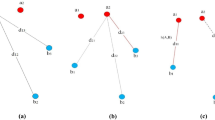Abstract
Intensity based registration methods, such as the mutual information (MI), do not commonly consider the spatial geometric information and the initial correspondences are uncertainty. In this paper, we present a novel approach for achieving highly-automatic 2D/3D image registration integrating the advantages from both entropy MI and spatial geometric features correspondence methods. Inspired by the scale space theory, we project the surfaces on a 3D model to 2D normal image spaces provided that it can extract both local geodesic feature descriptors and global spatial information for estimating initial correspondences for image-to-image and image-to-model registration. The multiple 2D/3D image registration can then be further refined using MI. The maximization of MI is effectively achieved using global stochastic optimization. To verify the feasibility, we have registered various artistic 3D models with different structures and textures. The high-quality results show that the proposed approach is highly-automatic and reliable.
Access this chapter
Tax calculation will be finalised at checkout
Purchases are for personal use only
Preview
Unable to display preview. Download preview PDF.
Similar content being viewed by others
References
Witkin, A.P.: Scale-space filtering. In: Proc. Int. Joint Conf. Artif. Intell., IJCAI Karlsruhe, pp. 1019–1021 (1983)
Lowe, D.G.: Distinctive image features from scale-invariant keypoints. International Journal of Computer Vision 60(2), 91–110 (2004)
Novatnack, J., Nishino, K.: Scale-dependent 3D geometric features. In: IEEE Eleventh International Conference on Computer Vision (2007)
Viola, P.A.: Alignment by maximization of mutual information. Technical Report AITR-1548 (1995)
Cleju, I., Saupe, D.: Stochastic optimization of multiple texture registration using mutual information. In: Hamprecht, F.A., Schnörr, C., Jähne, B. (eds.) DAGM 2007. LNCS, vol. 4713, pp. 517–526. Springer, Heidelberg (2007)
Lensch, P., Heidrich, W., Seidel, H.P.: Automated texture registration and stitching for real world models. In: Pacific Graphics (2000)
Floater, M.S., Hormann, K.: Surface parameterization: a tutorial and survey, pp. 157–186. Springer, Heidelberg (2005)
Yoshizawa, S., Belyaev, A., Seidel, H.-P.: A fast and simple stretch-minimizing mesh parametrization. In: Int. Conf. on Shape Modeling and Applications (2004)
Eck, M., DeRose, T., Duchamp, T., Hoppe, H., Lounsbery, M., Stuetzle, W.: Multiresolution analysis of arbitrary meshes. In: ACM SIGGRAPH 1995, pp. 173–182 (1995)
Förstner, W.: A feature based correspondence algorithm for image matching. Int. Arch. Photogrammetry Remote Sensing 26(3), 150–166 (1986)
Duda, R.O., Hart, P.E.: Pattern Classification, 2nd edn. Wiley Interscience, Hoboken (2000)
Faugeras, O.: Three-Dimensional Computer Vision: A Geometric Viewpoint. MIT Press, Cambridge (1993)
Hartley, R.I., Zisserman, A.: Multiple View Geometry in Computer Vision, 2nd edn. Cambridge University Press, Cambridge (2004)
Zhang, Z.: Parameter estimation techniques: A tutorial with application to conic fitting. Journal of Image and Vision Computing 15(1), 59–76 (1997)
Taylor, C.J., Kriegman, D.J.: Minimization on the lie group SO(3) and related manifolds. Technical report, Dept. of E.E. Yale University (1994)
Rodehorst, V., Hellwich, O.: Genetic algorithm sample consensus (GASAC) - a parallel strategy for estimation. In: 25 Years of RANSAC in CVPR (2006)
Penney, G.P., Edwards, P.J., King, A.P., Blackall, J.M., Batchelor, P.G., Hawkes, D.J.: A stochastic iterative closest point algorithm. In: Niessen, W.J., Viergever, M.A. (eds.) MICCAI 2001. LNCS, vol. 2208, p. 762. Springer, Heidelberg (2001)
Nishino, K., Sato, Y., Ikeuchi, K.: Appearance compression and synthesis based on 3D model for mixed reality. In: IEEE Int. Conf. Computer Vision, pp. 38–45 (1999)
Jank, Z., Chetverikov, D.: Photo-consistency based registration of an uncalibrated image-pair to a 3D model using genetic algorithm. In: 3DPVT, pp. 616–622 (2004)
Author information
Authors and Affiliations
Editor information
Editors and Affiliations
Rights and permissions
Copyright information
© 2010 Springer-Verlag Berlin Heidelberg
About this paper
Cite this paper
Zheng, H., Cleju, I., Saupe, D. (2010). Highly-Automatic MI Based Multiple 2D/3D Image Registration Using Self-initialized Geodesic Feature Correspondences. In: Zha, H., Taniguchi, Ri., Maybank, S. (eds) Computer Vision – ACCV 2009. ACCV 2009. Lecture Notes in Computer Science, vol 5996. Springer, Berlin, Heidelberg. https://doi.org/10.1007/978-3-642-12297-2_41
Download citation
DOI: https://doi.org/10.1007/978-3-642-12297-2_41
Publisher Name: Springer, Berlin, Heidelberg
Print ISBN: 978-3-642-12296-5
Online ISBN: 978-3-642-12297-2
eBook Packages: Computer ScienceComputer Science (R0)




